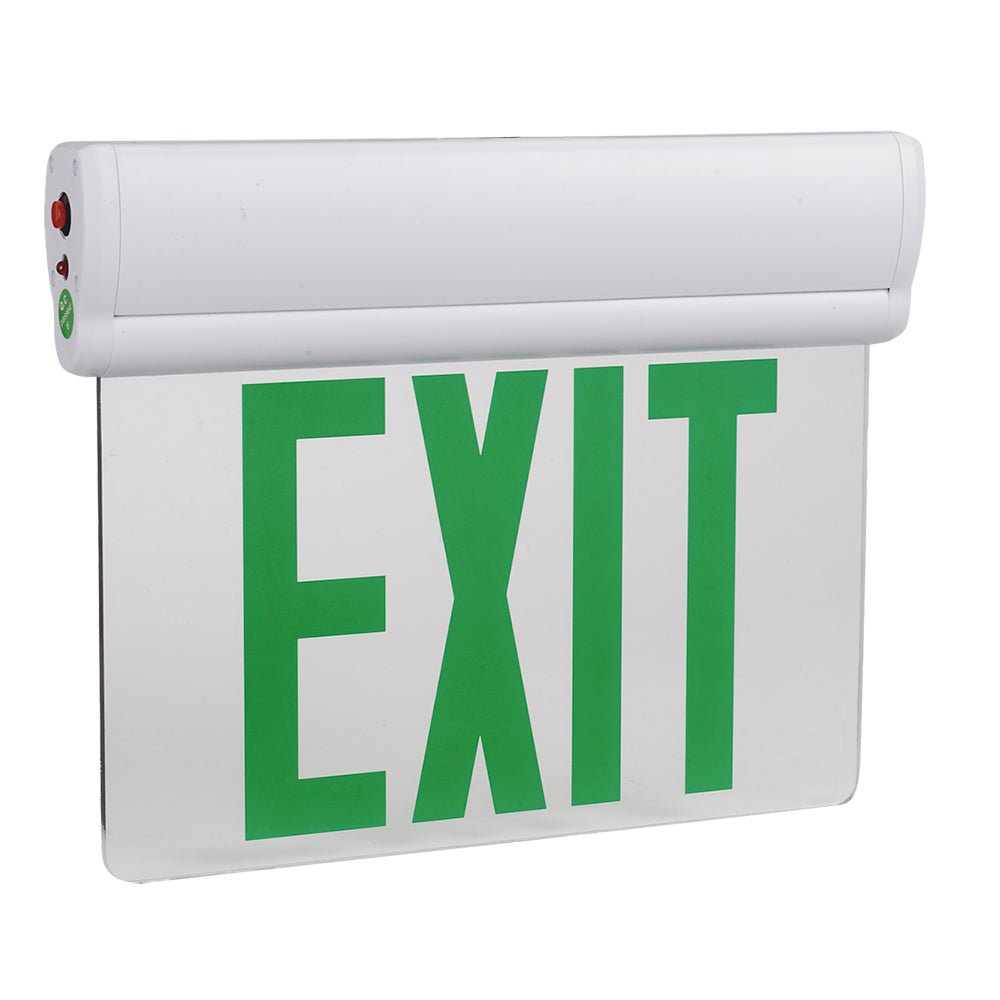Emergency exit signs are a crucial component of any building's safety plan. They provide clear guidance to occupants in case of an emergency and can potentially save lives. If you are responsible for the safety of a building, it is important to understand the requirements and best practices for installing emergency exit signs. In this article, we will explore the different aspects of installing exit signs, including types of exit signs, legal requirements, factors to consider, best practices, maintenance, benefits of LED Exit Signs, cost considerations, DIY vs. professional installation, troubleshooting, and frequently asked questions.
Understanding Exit Signs
Exit signs are designed to be easily visible and understandable to anyone, regardless of language or cultural barriers. They typically feature a pictogram of a running figure with an arrow pointing towards an exit, accompanied by the word "EXIT" in bold letters. The purpose of an exit sign is to provide clear and concise guidance to occupants in case of an emergency, indicating the nearest exit route.
Types of Exit Signs
Exit signs are available in different types, including electrically powered, self-luminous, and photoluminescent (glow-in-the-dark) exit signs. Electrically powered exit signs are the most common type and require a power source to illuminate. Self-luminous exit signs contain radioactive material that emits light without the need for external power, while photoluminescent exit signs absorb light during normal lighting conditions and emit light in the dark.
Legal Requirements for Emergency Exit Signs
The installation of exit signs is subject to various legal requirements and building codes, which vary by jurisdiction. It is essential to familiarize yourself with the specific regulations in your area to ensure compliance. In general, emergency exit signs are required in all commercial, public, and multi-occupancy buildings, including offices, hotels, schools, hospitals, shopping centers, and entertainment venues. The signs must be visible from any location within the building and should be placed above or near exits and exit routes, as well as along the exit access path to guide occupants to a safe exit.
Factors to Consider for Installing Exit Signs
When installing exit signs, several factors need to be taken into consideration to ensure their effectiveness. These include the layout and size of the building, the location and number of exits, the type of construction, the occupancy load, the presence of other emergency egress components, and the visibility of the signs from different areas of the building. It is important to conduct a thorough assessment of these factors to determine the appropriate type, quantity, and placement of exit signs for your building.
Best Practices for Installing Exit Signs
To ensure the optimal installation of exit signs, the following best practices should be followed:
- Place exit signs above or near exits and exit routes, ensuring they are clearly visible and unobstructed.
-
Install exit signs at a height of at least 6 feet from the floor, but not higher than 12 feet, to ensure they are easily readable by occupants of different heights.
-
Use arrows on exit signs to indicate the direction of the exit route, especially when the path to the exit is not immediately apparent.
-
Ensure that exit signs are well-lit and not obstructed by other objects or decorations, to ensure maximum visibility.
-
Install exit signs at all exit doors, stairwells, and other areas that lead to a safe exit, as well as along the exit access path to guide occupants to the nearest exit.
-
Follow the specific requirements of your local building codes and regulations for the installation of exit signs, including the use of approved exit sign materials, lettering size, and color contrast.
-
Regularly inspect and maintain exit signs to ensure they are functioning properly, including checking for any damage, dirt, or burnt-out bulbs, and promptly replacing or repairing any issues.
Benefits of LED Exit Signs
LED exit signs are becoming increasingly popular due to their energy efficiency, long lifespan, and bright illumination. LED exit signs use less electricity than traditional incandescent or fluorescent exit signs, resulting in cost savings on electricity bills. They also have a longer lifespan, which means less frequent replacement and maintenance. LED exit signs are known for their bright and clear illumination, making them highly visible even in low light conditions. Additionally, LED exit signs are environmentally friendly as they do not contain any hazardous materials, such as mercury, unlike fluorescent exit signs.
Cost Considerations for Installing Exit Signs
The cost of installing exit signs can vary depending on various factors, including the type and quantity of exit signs, the complexity of the installation process, and the labor rates in your area. Electrically powered exit signs tend to be cheaper upfront, but may have higher electricity costs over time. Self-luminous and photoluminescent exit signs may have higher initial costs but can result in long-term cost savings due to their low energy consumption and maintenance requirements. DIY installation may save on labor costs, but it is crucial to ensure compliance with local building codes and regulations. Professional installation may provide peace of mind, but it can be more expensive. It is essential to consider the long-term costs and benefits of different types of exit signs and installation methods when planning for the installation of emergency exit signs.
Common Mistakes to Avoid While Installing Exit Signs
When installing exit signs, it is important to avoid common mistakes that can compromise their effectiveness. Some common mistakes to avoid include:
-
Placing exit signs in locations that are not clearly visible or obstructed by other objects, reducing their effectiveness in guiding occupants to a safe exit.
-
Installing exit signs without considering the specific requirements of local building codes and regulations, leading to non-compliance and potential penalties.
-
Using exit signs with small or illegible lettering, poor color contrast, or incorrect placement of arrows, making them difficult to understand and follow.
-
Neglecting regular inspection and maintenance of exit signs, leading to burnt-out bulbs, dirt, or damage that can reduce their visibility and functionality.
-
Overlooking the importance of providing clear and concise emergency exit routes and signage in multiple languages, considering the diversity of building occupants.
By avoiding these common mistakes, you can ensure that your emergency exit signs are installed correctly and effectively in guiding occupants to safety in case of an emergency.

Maintaining and Testing Exit Signs
Regular maintenance and testing of exit signs are essential to ensure their ongoing functionality and effectiveness. It is important to follow the manufacturer's recommendations for maintenance and testing, as well as any local building codes or regulations. Some general maintenance and testing procedures for exit signs include:
-
Regularly inspecting exit signs for any damage, dirt, or burnt-out bulbs, and promptly replacing or repairing any issues.
-
Cleaning exit signs to ensure maximum visibility, especially if they are located in dusty or dirty areas.
-
Testing exit signs at least once a month by pressing the test button or simulating a power outage to ensure they are functioning properly.
-
Keeping records of maintenance and testing activities, including dates and any repairs or replacements made.
-
Training designated personnel on how to properly inspect, clean, and test exit signs, and ensuring they are familiar with the location and operation of all exit signs in the building.
By regularly maintaining and testing exit signs, you can ensure that they are always in proper working condition and able to guide occupants to safety during an emergency.
Conclusion
Emergency exit signs are a critical component of building safety, providing clear and visible guidance to occupants in case of an emergency evacuation. Proper installation, use of LED exit signs, compliance with local building codes and regulations, and regular maintenance and testing are essential for ensuring the effectiveness of exit signs in guiding occupants to safety. By avoiding common mistakes and following best practices, you can ensure that your emergency exit signs are reliable and functional when they are needed the most.
FAQs (Frequently Asked Questions)
- Are LED exit signs more expensive than traditional exit signs?
LED exit signs may have higher upfront costs, but they can result in long-term cost savings due to their energy efficiency and longer lifespan compared to traditional incandescent or fluorescent exit signs.
- Can I install exit signs myself without professional help?
DIY installation of exit signs is possible, but it is crucial to ensure compliance with local building codes and regulations to ensure their effectiveness in guiding occupants to safety.
- How often should I test my exit signs?
Exit signs should be tested at least once a month to ensure they are functioning properly. Additional testing may be required based on local building codes or regulations.
- Can exit signs be installed outdoors?
Exit signs should be installed indoors, as outdoor conditions may affect their visibility and functionality. Outdoor areas should be properly illuminated and have clear signage indicating the nearest exit.
- Do I need to provide multilingual exit signs in my building?
Providing multilingual exit signs is recommended to accommodate the diversity of building occupants and ensure that all occupants can understand and follow the emergency exit routes.




















































































1 comment
I work in a hospital, and I noticed there are exit signs on both sides of the doors. One over the door in the direction leaving the area to an exit, and one over that same door leading to the patient rooms. Does this make any sense??